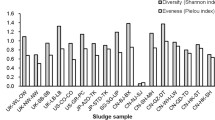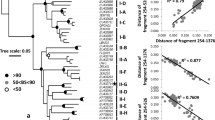Abstract
The performance of enhanced biological phosphorus removal (EBPR) wastewater treatment processes depends on the presence of bacteria that accumulate large quantities of polyphosphate. One such group of bacteria has been identified and named Candidatus Accumulibacter phosphatis. Accumulibacter-like bacteria are abundant in many EBPR plants, but not much is known about their community or population ecology. In this study, we used the polyphosphate kinase gene (ppk1) as a high-resolution genetic marker to study population structure in activated sludge. Ppk1 genes were amplified from samples collected from full-scale wastewater treatment plants of different configurations. Clone libraries were constructed using primers targeting highly conserved regions of ppk1, to retrieve these genes from activated sludge plants that did, and did not, perform EBPR. Comparative sequence analysis revealed that ppk1 fragments were retrieved from organisms affiliated with the Accumulibacter cluster from EBPR plants but not from a plant that did not perform EBPR. A new set of more specific primers was designed and validated to amplify a 1,100 bp ppk1 fragment from Accumulibacter-like bacteria. Our results suggest that the Accumulibacter cluster has finer-scale architecture than previously revealed by 16S ribosomal RNA-based analyses.


Similar content being viewed by others
References
Ahn KH, Kornberg A (1990) Polyphosphate kinase from Escherichia coli—purification and demonstration of a phosphoenzyme intermediate. J Biol Chem 265:11734–11739
Akiyama M, Crooke E, Kornberg A (1992) The polyphosphate kinase gene of Escherichia coli—isolation and sequence of the ppk gene and membrane location of the protein. J Biol Chem 267:22556–22561
Altschul SF, Gish W, Miller W, Myers EW, Lipman DJ (1990) Basic local alignment search tool. J Mol Biol 215:403–410
APHA (1995) Standard methods for the examination of water and wastewater. Washington DC, USA, American Public Health Association/American Water Works Association/Water Environment Federation
Beer M, Stratton HM, Griffiths PC, Seviour RJ (2006) Which are the polyphosphate accumulating organisms in full-scale activated sludge enhanced biological phosphate removal systems in Australia? J Appl Microbiol 100:233–243
Crocetti GR, Hugenholtz P, Bond PL, Schuler A, Keller J, Jenkins D, Blackall LL (2000) Identification of polyphosphate accumulating organisms and the design of 16S rRNA-directed probes for their detection and quantitation. Appl Environ Microbiol 66:1175–1182
Dojka MA, Hugenholtz P, Haak SK, Pace NR (1998) Microbial diversity in a hydrocarbon and chlorinated solvent-contaminated aquifer undergoing intrinsic bioremediation. Appl Environ Microbiol 64:3869–3877
Garcia Martin H, Ivanova N, Kunin V, Warnecke F, Barry K, McHardy AC, Yeates C, He S, Salamov A, Szeto E, Dalin E, Putnam N, Rigoutsos I, Kyrpides N, Blackall LL, McMahon KD, Hugenholtz P (2006) Metagenomic analysis of phosphorus removing sludge communities. Nature Biotechnol 24:1263–1269
Gevers D, Cohan FM, Lawrence JG, Spratt BG, Coenye T, Feil EJ, Stackebrandt E, Van de Peer Y, Vandamme P, Thompson FL, Swings J (2005) Re-evaluating prokaryotic species. Nature Rev Microbiol 3:733–739
He S, Gu AZ, McMahon KD (2006) Fine-scale differences between Accumulibacter-like bacteria in enhanced biological phosphorus removal activated sludge. Water Sci Technol 54:111–117
He S, Gu AZ, McMahon KD (2007) Progress towards understanding the distribution of Accumulibacter among full-scale enhanced biological phosphorus removal systems. Microb Ecol (in press)
Hesselmann RPX, Werlen C, Hahn D, van der Meer JR, Zehnder AJB (1999) Enrichment, phylogenetic analysis and detection of a bacterium that performs enhanced biological phosphate removal in activated sludge. Syst Appl Microbiol 22:454–465
Huelsenbeck JP, Ronquist F (2001) Mrbayes: Bayesian inference of phylogenetic trees. Bioinformatics 17:754–5
Kong YH, Nielsen JL, Nielsen PH (2004) Microautoradiographic study of Rhodocyclus-related polyphosphate accumulating bacteria in full-scale enhanced biological phosphorus removal plants. Appl Environ Microbiol 70:5383–5390
Lee N, Nielsen PH, Aspegren H, Henze M, Schleifer KH, Jansen JL (2003) Long-term population dynamics and in situ physiology in activated sludge systems with enhanced biological phosphorus removal operated with and without nitrogen removal. Syst Appl Microbiol 26:211–227
Levantesi C, Serafim LS, Crocetti GR, Lemos PC, Rossetti S, Blackall LL, Reis MAM, Tandoi V (2002) Analysis of the microbial community structure and function of a laboratory scale enhanced biological phosphorus removal reactor. Environ Microbiol 4:559–569
Liu WT, Nielsen AT, Wu JH, Tsai CS, Matsuo Y, Molin S (2001) In situ identification of polyphosphate- and polyhydroxyalkanoate-accumulating traits for microbial populations in a biological phosphorus removal process. Environ Microbiol 3:110–122
McMahon KD, Dojka MA, Pace NR, Jenkins D, Keasling JD (2002a) Polyphosphate kinase from activated sludge performing enhanced biological phosphorus removal. Appl Environ Microbiol 68:4971–4978
McMahon KD, Jenkins D, Keasling JD (2002b) Polyphosphate kinase genes from activated sludge carrying out enhanced biological phosphorus removal. Water Science & Technology 46:155–162
Oehmen A, Yuan ZG, Blackall LL, Keller J (2005) Comparison of acetate and propionate uptake by polyphosphate accumulating organisms and glycogen accumulating organisms. Biotechnol Bioeng 91:162–168
Pijuan M, Saunders AM, Guisasola A, Baeza JA, Casas C, Blackall LL (2004) Enhanced biological phosphorus removal in a sequencing batch reactor using propionate as the sole carbon source. Biotechnol Bioeng 85:56–67
Purkhold U, Pommerening-Roser A, Juretschko S, Schmid MC, Koops H-P, Wagner M (2000) Phylogeny of all recognized species of ammonia oxidizers based on comparative 16S rRNA and amoA sequence analysis: Implications for molecular diversity surveys. Appl Environ Microbiol 66:5368–5382
Ronquist F, Huelsenbeck JP (2003) Mrbayes 3: Bayesian phylogenetic inference under mixed models. Bioinformatics 19:1572–1574
Schuler AJ, Jenkins D (2003) Enhanced biological phosphorus removal from wastewater by biomass with different phosphorus contents. Part I: Experimental methods and results. Water Environ Res 75:485–498
Tzeng CM, Kornberg A (1998) Polyphosphate kinase is highly conserved in many bacterial pathogens. Mol Microbiol 29:381–382
Wintzingerode FV, Goebel UB, Stackebrandt E (1997) Determination of microbial diversity in environmental samples: Pitfalls of PCR-based rRNA analysis. FEMS Microbiol Rev 21:213–229
Zilles JL, Hung CH, Noguera DR (2002a) Presence of Rhodocyclus in a full-scale wastewater treatment plant and their participation in enhanced biological phosphorus removal. Water Sci Technol 46:123–128
Zilles JL, Peccia J, Kim M-W, Hung C-H, Noguera DR (2002b) Involvement of Rhodocyclus-related organisms in phosphorus removal in full-scale wastewater treatment plants. Appl Environ Microbiol 68:2763–2769
Acknowledgements
The authors wish to thank Philip Hugenholtz, Hector Garcia Martin, Victor Kunin, Jason Flowers, and Daniel Noguera for helpful discussions. This research was supported by National Science Foundation Grants BES-9912472 and BES-0332181 to DJ and JDK, and by BES-0332136 to KDM.
Author information
Authors and Affiliations
Corresponding author
Electronic supplementary material
Below is the link to the electronic supplementary material.
ESM
Polyphosphate kinase genes from full-scale activated sludge plants (DOC 802 kb)
Rights and permissions
About this article
Cite this article
McMahon, K.D., Yilmaz, S., He, S. et al. Polyphosphate kinase genes from full-scale activated sludge plants. Appl Microbiol Biotechnol 77, 167–173 (2007). https://doi.org/10.1007/s00253-007-1122-6
Received:
Revised:
Accepted:
Published:
Issue Date:
DOI: https://doi.org/10.1007/s00253-007-1122-6




